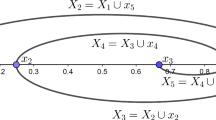Abstract
An ongoing and controversial topic of congressional scholars is the question “Are committees ‘preference outliers’ vis-a-vis their parent chamber?” Despite numerous research efforts showing isolated cases of outlying committees, little evidence shows a systematic tendency for committees to be unrepresentative of their legislature. A paper which comes close to being an exception is Weingast and Marshall's (1988) analysis of “the industrial organization of Congress,” which reports evidence of many and very strongly outlying committees. However, the apparently strong evidence is due more to the authors' incorrectly executed methods than to a general tendency for committees to be outliers. In this note I review the state of the committee-outlier debate and also show that Weingast and Marshall's empirical results cannot be replicated. I accordingly provide the correct results once their statistical tests are properly executed.
Similar content being viewed by others
References
Arnold, R.D. (1979).Congress and the bureaucracy. New Haven: Yale University Press.
Black, D. (1958).The theory of committees and elections. London: Cambridge University Press.
Cowart, S. (1981). Representation of high-demand constituencies on review committees.Public Choice 37: 337–342.
Cox, G. and McCubbins, M. (1989). Parties and committees in the U.S. House of Representatives. University of California, San Diego. Manuscript.
Denzau, A.T. and Mackay, R.J. (1983). Gatekeeping and monopoly power of committees: An analysis of sincere and sophisticated behavior.American Journal of Political Science 27: 740–761.
Fenno, R. (1966).The power of the purse: Appropriations politics in Congress. Boston: Little, Brown.
Gilligan, R. and Krehbiel, K. (1987). Collective decision-making and standing committees: An informational rationale for restrictive amendment procedures.Journal of Law, Economics, and Organization 3: 287–335.
Gilligan, T. and Krehbiel, K. (1989). Asymetric information and legislative rules with heterogeneous committee.American Journal of Political Science 33: 459–490.
Gilligan, T. and Krehbiel, K. (1990). Organization of informative committees by a rational legislature.American Journal of Political Science 34: 531–564.
Groseclose, T. (1992). Median-based tests of committee composition. Carnegie Mellon University. Manuscript.
Hall, R. and Grofman, B. (1990). The committee assignment process and the conditional nature of committee bias.American Political Science Review 84: 1149–1166.
Kramer, G.H. (1972). Sophisticated voting over multidimensional choice spaces.Journal of Mathematical Sociology 2: 165–180.
Krehbiel, K. (1990). Are congressional committees composed of preference outliers?American Political Science Review 84: 149–163.
Krehbiel, K. (1991).Information and legislative organization. Ann Arbor: University of Michigan Press.
Krehbiel, K. (1992). Deference, extremism, and interest group ratings. Stanford University. Manuscript.
Larsen, R.J. and Marx, M.L. (1981).An introduction to mathematical statistics and its applications. Englewood Cliffs, NJ: Prentice-Hall.
Manley, J. (1969). Wilbur Mills: A study in congressional influence.American Political Science Review 63: 442–464.
McCurdy, K. (1991). Preference outliers and environmental politics. University of Missouri, Columbia, Missouri. Manuscript.
Ray, B. (1980). The responsiveness of the U.S. Congressional Armed Services Committees to their parent bodies.Legislative Studies Quarterly 5: 501–515.
Richardson, L. (1990). A test of committee preferences and committee power. University of Tennessee. Manuscript.
Shepsle, K. (1978).The giant jigsaw puzzle: Democratic committee assignments in the modern House. Chicago: University of Chicago Press.
Shepsle, K. (1979). Institutional arrangements and equilibrium in multidimensional voting models.American Journal of Political Science 23: 27–60.
Weingast, B. and Marshall, W. (1988). The industrial organization of Congress: Or, why legislature, like firms, are not organized as markets.Journal of Political Economy 96: 132–163.
Author information
Authors and Affiliations
Rights and permissions
About this article
Cite this article
Groseclose, T. The committee outlier debate: A review and a reexamination of some of the evidence. Public Choice 80, 265–273 (1994). https://doi.org/10.1007/BF01053220
Accepted:
Issue Date:
DOI: https://doi.org/10.1007/BF01053220




